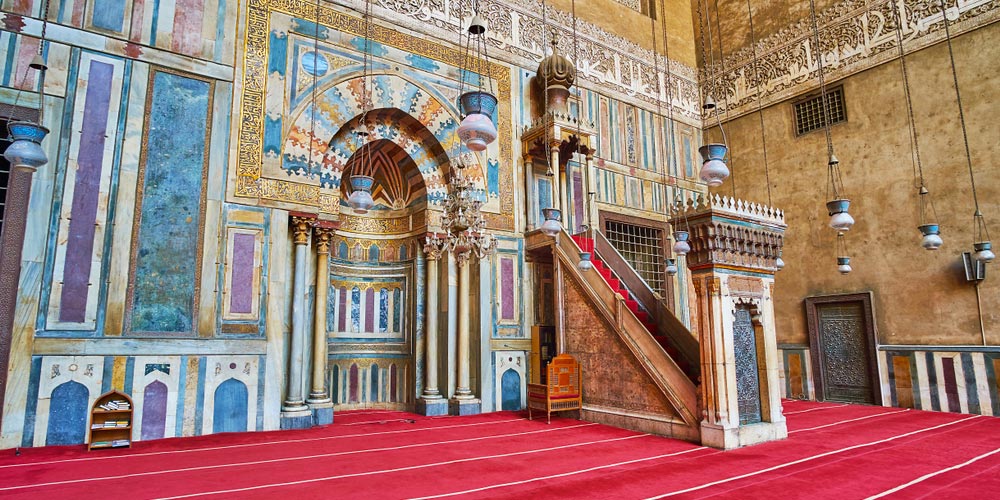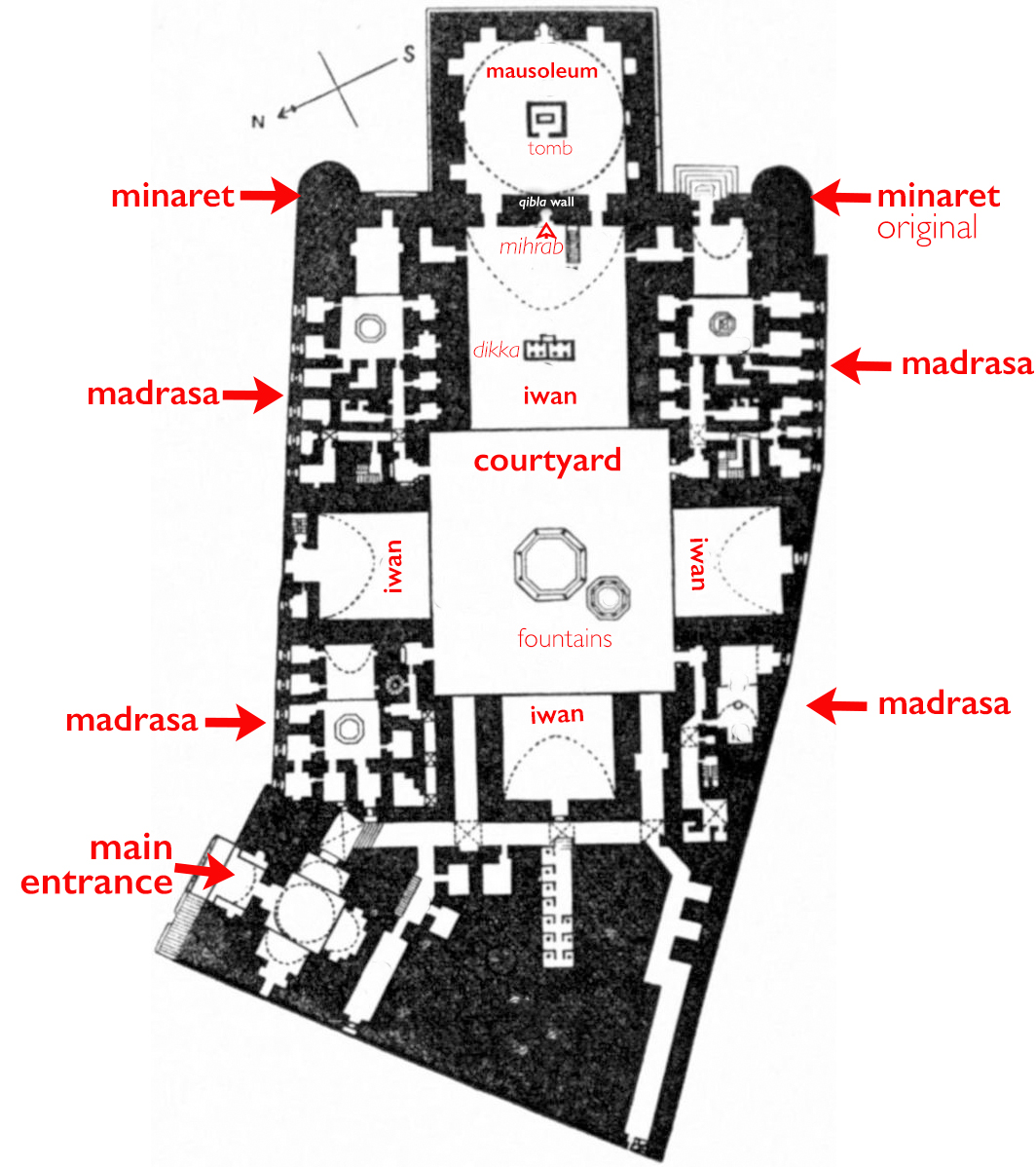The Mosque and Madrasa of Sultan Hassan: A Masterpiece of Mamluk Architecture
Step into the past and immerse yourself in the stunning architectural marvel of the Mosque and Madrasa of Sultan Hassan. Located in Cairo, Egypt, this masterpiece of Mamluk architecture has stood the test of time, captivating visitors with its intricate details and historical significance. Built-in the 14th century by Sultan Hassan, this grand structure is a testament to the sophisticated artistry and engineering of the time. Join us as we explore the features and significance of this stunning site, and discover why it continues to be a must-visit destination for history and architecture enthusiasts alike.

Overview of the Mosque and Madrasa of Sultan Hassan
Are you looking for an adventure to experience the ultimate Egyptian knowledge? Then you should not miss the opportunity to visit the Mosque and Madrasa of Sultan Hassan, located in Cairo, Egypt. This magnificent architectural masterpiece was built between 1356 and 1363 during the Mamluk period and is considered one of Cairo's most impressive historic monuments today. It's massive size and innovative architectural design make it a prime example of early Mamluk architecture. Its towering minarets, high walls, and beautiful courtyard offer a glimpse into the grand architectural achievements of the period.
The mosque served as a school or madrasa and a congregational mosque for Friday sermons. It was meant to hold up to 400 students, making it one of the largest educational centres in the Islamic world. The significance of this mosque is further evidenced by its prime location near the Citadel, which served as the centre of Mamluk activity.
The founder of this great monument was Sultan Hassan, who ruled Egypt twice. During his first reign in 1347, he was dethroned by other Mamluk princes and generals. His second reign began in 1356 and lasted until 1361 he was tragically assassinated. Sultan Hassan imported engineers from throughout the world to build his great monument, funded by resources from the estates of people who died in the Black Death that struck Cairo in 1348.
Today, the Mosque and Madrasa of Sultan Hassan stand as a testament to the grand achievements of the Mamluk period. Its massive size, innovative design, and educational role make it an important monument in Islamic history. Plan to visit this magnificent structure in the morning to see it's a beautiful mausoleum and the western iiwan lit up by the sun. Don't miss the opportunity to learn about the grand architectural achievements of the Mamluk period by visiting this important historical monument. [1][2]

Importance of the mosque in Mamluk Cairo
Do you appreciate the rich history and intricate architecture of different cultures? If so, the Mosque and Madrasa of Sultan Hassan in Cairo is a must-see. This monument is considered to be one of the major pillars of the Islamic world, and it is easy to see why. The founder of this massive structure was Sultan Hassan, who imported engineers from all over the world to build this impressive complex. It is one of the largest mosques in the Islamic world, measuring 150 meters long and 36 meters high, with its tallest minaret reaching 68 meters high. Despite severe challenges, such as the Black Death that struck Cairo in 1348 and intermittent political turmoil throughout its construction, this remarkable structure still stands tall today.
The mosque was also a learning centre, serving as a school or madrasa for four hundred students and as a congregational mosque for Friday sermons. Its location near the Citadel, the centre of Mamluk activity, only made it more important in the eyes of the people. However, its construction was not without controversy. Sultan Hassan funded this project with rather dark resources, using money from the estates of people who died in the Black Death. The people of the time were not pleased with this policy, which earned him a reputation for greed. Unfortunately, construction costs added to this negative image, with an average cost of 20,000 dirhams daily for five years. Even the Sultan himself said that he would have abandoned the project if not for the shame that would come with not completing a mosque he had started.
Despite these difficulties, the Mosque and Madrasa of Sultan Hassan remains impressive monument that must be seen in person to appreciate its grandeur truly. So, whether you plan to visit Egypt in person or experience it online, don't miss this exquisite piece of Mamluk architecture. [3][4]

Construction of the massive structure
If you're looking for an architectural gem in Cairo, the Mosque and Madrasa of Sultan Hassan should be on your list. This massive structure, commissioned by Sultan Hassan during his second reign in 1356, has been praised as one of the most impressive historical monuments in the Islamic world.
Standing some 150 meters long and 36 meters high, it's considered one of the largest mosques in Cairo and the entire Islamic world. Its tallest minaret is 68 meters tall! What makes it even more fascinating is that it was built during a time when the Black Death struck Cairo, killing many inhabitants. Funding for the mosque came from rather dark resources - the estates of people who died in the outbreak.
Despite the high cost, Sultan Hassan's obsession with completing the mosque was probably due to a fear of being labelled insufficient. His father, Al Nasser Mohamed, was also a great builder responsible for many monuments around Egypt, including a Madrasa in Ben El Qasrien. Sultan Hassan imported engineers from all around the world to build his great monument.
However, construction was not without its challenges. After five years, one of its minarets collapsed, killing over 300 people. And just two years before the mosque was completed in 1363, Sultan Hassan was assassinated, making the completion an even more important matter of legacy.
Despite Sultan Hassan's dethronement and assassination, his huge facade still stands as a testament to his ambitious vision and the incredible engineering capabilities of the time. If you're ever in Cairo, visit this masterpiece of Mamluk architecture, considered one of the finest ancient mosques in Cairo and the world.[5][6]

Funding and financial aspects of the project
Are you a history buff or just looking for a unique adventure in Egypt? The Mosque and Madrasa of Sultan Hassan should be on your list! This impressive structure was built between 1356 and 1363 during the reign of Sultan Hassan and is considered one of Cairo's finest examples of early Mamluk architecture. It is also one of the largest mosques in the Islamic world, measuring 150 meters long and 36 meters high, and was intended to house 400 students. However, did you know that funding for this magnificent mosque came from rather dark resources? It was financed by the estates of people who died in the Black Death that struck Cairo in 1348. Though not a very popular policy among the people of the time, construction continued under the supervision of Prince Muhammad Ibn Baylik al-Muhssani at an average cost of 20,000 dirhams every day for five years.
It is reported that Sultan Hassan considered abandoning the project due to its exorbitant cost but did not want to disgrace himself for starting a mosque he could not finish. Unfortunately, five years into its construction, one of the minarets collapsed, killing over 300 people. This was seen as a bad omen, and combined with the Sultan's reputation for being greedy, made him unpopular among the Mamluk elites. In 1361, Sultan Hassan was assassinated by his commander-in-chief, a Mamluk thought to be loyal, due to his extravagance in spending fortunes on women and other forms of favouritism. Sultan Hassan's body was never found, and the mausoleum never served its intended purpose. The mosque was eventually finished by one of his functionaries, Bashir al-Gamdar.
Despite its tumultuous history, the Mosque and Madrasa of Sultan Hassan remain a masterpiece of Mamluk architecture that's worth a visit. From its massive size and innovative architectural components to its unfortunate funding and financial history and the intrigue surrounding its construction and the reign of its founder, there's plenty to explore and discover about this remarkable monument. So why not see it for yourself? Travel to Egypt with Tour Egypt or enjoy a virtual experience from the comfort of your own home. [7][8]

Role of Engineering in the Construction
If you're looking for a fascinating destination to explore in Egypt, the Mosque and Madrasa of Sultan Hassan should be on your list. This architectural masterpiece is regarded as Cairo's finest example of early Mamluk architecture, and it's easy to see why. Built-in the 14th century under the supervision of Prince Mohammad Ibn Baylik Al Muhssani, this mosque is truly massive. Its elongated structure measures an impressive 150 meters in length and stands tall at 36 meters. It's one of the largest mosques in Egypt and the Islamic world.
What's more, it was built with the help of engineers from all over the world, reflecting the incredible wealth and power of Sultan Hassan during his second reign as Egypt's ruler. But despite his resources, completing the mosque wasn't easy - construction took five long years and wasn't without tragedy. One of the minarets collapsed, leading to the loss of over 300 lives. This was seen as a bad omen, and sadly, things didn't improve much for Sultan Hassan. In 1361, he was assassinated by his commander-in-chief, who rebelled against him due to Sultan's profligate spending habits and reputation for greed.
Despite these dark moments in its history, the Mosque and Madrasa of Sultan Hassan is still a stunning sight. Its towering minaret reaches 68 meters in height, and the entire mosque was once intended to house around 400 students. It's not just a place of beauty; it's also a piece of history, revealing not just the architectural genius and wealth of the Mamluk period but also the intrigue and politics that shaped that era. No wonder guidebooks speak of it in such glowing terms. If you're planning a visit to Cairo, this remarkable and historic building should be on your itinerary. [9][10]

Sultan Hassan's reign and assassination
As you explore the wonders of Egypt, make sure not to miss the breathtaking Mosque and Madrasa of Sultan Hassan, a true masterpiece of Mamluk architecture. Built between 1356 and 1363, this monument is one of Cairo's most impressive historical landmarks.
Sultan Hassan, son of Mamluk Sultan Al Nasser Mohamed Ibn Qalawoun, commissioned the construction of this majestic structure, which was meant to house around 400 students. However, his reign was not glorious, as he was more of a puppet manipulated by powerful amirs. He faced many challenges, including an unsuccessful attempt to build a mosque using funds from the estates of people who died in the Black Death, making him quite unpopular among the people of Cairo.
Despite its tumultuous history, Sultan Hassan imported engineers from all over the world to build his magnificent mosque, making it an amazing work of art and an engineering marvel. The mosque is massive, measuring around 150 meters long and 36 meters high, and has been referred to as the largest mosque in Cairo and the Islamic world.
One of its prominent features, the minaret, rises to an imposing height of 68 meters. At the same time, its impressive western iwan and stunning mausoleum are best appreciated when illuminated by the morning sun. An interesting fact about the mosque’s construction is that the cost was an average of 20,000 dirhams daily for about five years. However, about five years into its construction, one of the minarets collapsed, killing over three hundred people, leading many to believe it was a bad omen.
Despite many struggles, Sultan Hassan did not abandon his dream of completing this great monument, even though it ultimately did not serve its intended purpose, as he was assassinated two years before its completion. Thus, one of his functionaries, Bashir Al Gamdar, finished the mosque.
Today, the Mosque and Madrasa of Sultan Hassan are a reminder of the great potential that can be achieved with passion and innovation.[11][12]
